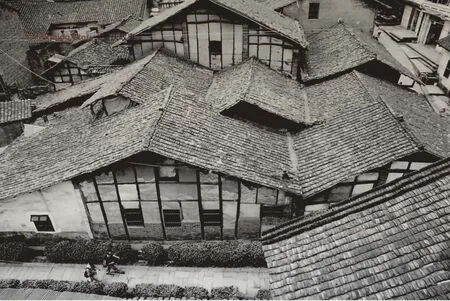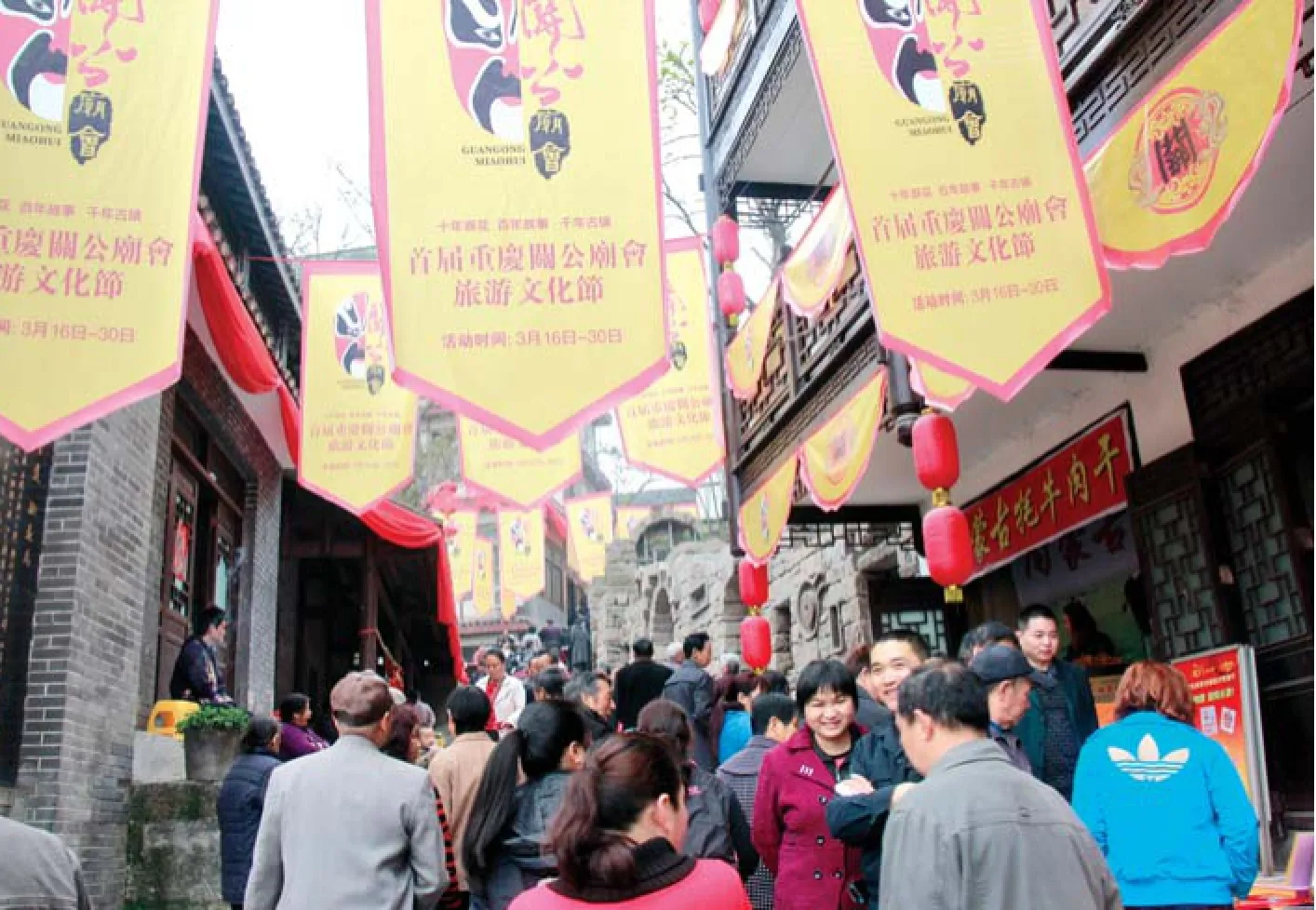千年驿道走马镇 道不尽的记忆沧桑
2015-09-09李静
□ 文/本刊记者 李静
千年驿道走马镇道不尽的记忆沧桑
□ 文/本刊记者 李静

图片由走马镇提供
绵绵细雨,不住地扑向石板路中旧时马帮踏出的蹄痕,无声亦无痕,一如古镇深邃的历史与昔日繁华;茶馆里依旧满座,系着白布围裙的跑堂忙着用长嘴茶壶四处招呼,说书人嘴里依然是那部永远也没讲完的三国,只有那偶尔响起的手机铃声和拍照发微信的手机光亮,能让你不时穿透时空回到喧嚣的当下。
如果请今天的人们用时间表述“重庆到成都”的距离,得到最多的答案恐怕是“两个小时”,几乎等于和三五朋友一起小聚的时间。但在以前肩挑背驮的漫长岁月中,两地往来主要是走成渝古驿道。“三街五驿四镇七十二堂口”,这句老话便是昔日千里古驿道繁华的真实写照。
城市变迁、沧海桑田,青石铺就的古驿道早已湮没,如今,唯有九龙坡区走马古镇境内的一段古驿道还保存完好。经过千年风雨洗礼后,再探走马古驿道,背后已是说不完的故事,道不尽的记忆。
千年古镇 故事之乡
民谚有“故事家家户户讲,男人讲,女人讲,娃娃也能讲;山歌年年月月唱,台上唱,坡上唱,处处都在唱。”在走马这座不大的古镇上,民间文艺的兴盛已经渗透到每一个角落。从何时开始修建?又是什么时候发展成了今日的民间故事之乡?这一说来,皆是故事。
相传,三国时候,刘备建都成都,赵云镇守江州,即现在的重庆。赵云的府邸便在走马岗高家石坝,走马一脚踏三县,便于提兵调将。某日,刘备与孔明来此检阅军情,远远看见此处山形似一批奔马,于是孔明便给此地取名为走马岗。
至宋代之时,这里已经成为了一个成形的驿站。而走马岗的鼎盛时期是在明朝中期,作为重庆到成都必经的第一个驿站,其一脚踏三县的地理位置,决定了它成为当时的陆上交通枢纽和贸易中心,三教九流汇聚之地,也成了巴渝文化民间繁衍传播的温床。
商贾旅人从重庆出发至此已是人乏马困,还要翻一座大山才能到达璧山县的来凤驿,走马街与来凤驿之间大山横亘,越山横道长约30华里,山上林木阴森,悬崖绝壁,常有虎豹出没,亦为盗贼猖狂之所,故凡有重庆沿驿道东来的客旅,均多在此集结成对,于白天翻越大山西行,众多商贾力夫夜宿走马岗。安顿好马匹,在这古驿站酒足饭饱后,月亮才升起不到中天,夜未央,人难眠,客商门便不由自主三三两两来到茶馆。”相逢何必曾相识”,于是相识的不相识的、做老板当小二的、不论贫富贵贱,捧着一碗清茶,或许还就着一碟小瓜子儿,便坐在了一块。你言我语,好不热闹,论国家事,谈家乡情,说言子,谈心声……
小镇的居民在潜移默化、耳濡目染下,个个都成了讲故事的高手。久而久之,在走马这片热土上发掘出了以民间故事为主,兼含歌谣、谚语、俗语的蔚为大观的“走马镇民间文学”,其中的“走马镇民间故事”篇目繁多、内容浩瀚。更加令人欣喜的是,在走马这片里弄村舍中,还活跃着一个颇具规模的民间故事讲说人群体。1998年,被联合国教科文组织、中国民间文艺家协会联合授予“中国民间故事家”称号的魏显德先生及其堂弟魏显发,便是这些民间故事讲说人中佼佼出众的两位代表人物。
迄今为止,走马已发掘出故事家群体316人,全镇已搜集民间故事目录10915则,已采录故事9714则,民间歌谣3000余首,记录各类文字资料近700万字。
2006年8月,走马镇民间故事被列入首批“国家级非物质文化遗产”;2007年12月,走马古镇被评为国家级历史文化名镇”;2009年8月,走马镇被授予“中国曲艺之乡”称号。

走马古民居 摄影:曾朝文
古道西风“瘦”马
寻访如今的走马古镇,乘车至白市驿转车,半个小时后便可到达。抬头望去,是一段不长的青石梯坎,一矗斑驳而古老的宅子,一棵上了年纪的黄桷树。拾级而上,便来到走马场的城墙前面,高大恢弘的城墙呈弧形,中间是拱形石门,上书“走马场”三个繁体字,两旁一副对联,左边为“现实讲团体关了门既是一家”,右为“入世多迷途由此去方为正路”,字字力道遒劲,寓意深邃,充分体现出走马人的大气。街门旁边的墙上嵌着刻有“中国曲艺之乡”、“中国历史文化名镇”等字样的石碑,著名相声表演艺术家姜昆为走马镇题词的石碑也立于石门前:“黄桷正阳,走马镇一语千言万人心,今古悲欢故事里,明朝尽是听说人。”这些都表示着走马古镇的地位与荣耀。从石门向内望去,一条悠长的青石板路,两排古老的旧时民居,白天街上零星的几个人,似乎都在诉说着今日走马的落寞。
步入门内,一眼便被左边雄伟的的关公武庙戏楼镇住了。这座建于明清的戏楼,至今依然保存完好,戏楼分两层,上面是戏台,下面是茶园,整座戏楼以石料托底,木料为身,滚筒瓦为盖;风檐龙柱,雕阁画屏,喷漆涂金,精妙绝伦;龙凤棱爪,人物举止,栩栩如生,巧夺天工。听说以前每逢佳节庙会,均有戏班登临,献艺者既有吴晓雷、陈淑芳等川剧名家,又有本镇的业余演员,每每看到精妙绝伦之处,台下看客爆发出的掌声、呐喊声经久不息。
而如今,在朝云暮雨的轮回中,千年走马驿道只留下了些许的清冷与寂寥。我们只能站在这戏台下想象着昔日的繁华景象,一切似乎都消失在冷冷的“西风”中。漫步久远的青石路、马帮的蹄痕、深深的槽印虽依旧清晰可寻。“哒哒”的马蹄声却已经远去,那段因驿站而兴旺的岁月也以这样的方式,永远存在在古镇的记忆里。
沿着这条青石板路向前,街两边为依山就势、自由排列、错落有致的商铺店面、民居院落、宫庙建筑,形成一个具有古典韵味的传统街区。剃头铺、茶馆、饭馆、照相馆、客栈……每个店面屋檐下挂着的招牌旗幡摇曳在风中,似乎在为这匹古道“瘦”马增添几分萧瑟与凉意。
挽留最后的古驿道
走马驿道是重庆主城区内仅存的古驿道,为重现驿道昔日风貌,政府将投入8000万元集中升级改造走马古镇。走马镇目前已完成古镇改造及风貌设计,形成修建性详规,恢复关武庙建筑群,并修复古成渝驿道3公里。该镇还将逐步恢复文昌宫、南华宫、万寿宫等建筑群;打造刘家、邓家、孙家大院等院落群;恢复茶馆酒馆、剧院等临街商铺群;恢复古驿道,收集成渝古驿道上的历史遗存和典故,修建成渝古驿道三街、四驿、七十二堂等景观,修建驿道博物馆,配套开发明清时期的商铺、民居,打造驿道文化区。
为保护走马民间故事这一非物质文化遗产,当地还成立了走马民间故事保有会,负责保护、传承走马民间故事。同时,还组织了“走马民间曲艺协会”,由“国家级故事传承人”刘远扬担任名誉会长,下设民间山歌队、故事队、川剧坐唱队、曲艺队、民乐吹打队和书画协会等20余支基层队伍,常邀请市内外的专家学者,进行故事讲述、舞台表演、曲艺赏析等方面的指导。
如今的走马正在被努力打造成重庆的口岸重镇、文化名镇和旅游强镇。头顶“国家级历史文化名镇”、“国家级非物质文化遗产”、“中国曲艺之乡”、“中国传统村落”四块“国字号”招牌的走马镇,正像一匹奔腾的骏马,大踏步地向前发展。
● 编辑:曾睿
Chengdu and Chongqing are nothing less than A Tale of Two Cities by Charles Dickens and the quasi high-speed train Harmony brushed a legendary chapter of the two-hour economic circle. The launch of the high-speed train will make Sichuan and Chongqing closer in the future. Nevertheless in those days the shoulder carrying was considered the main transport on the ancient route. As an old saying goes, “three streets, five post stops, four towns, and seventy-two fairs”truly depicts the vicissitudes of the century-old post road.
The world evolved, so did city. The ancient post road with stone pavement is long gone. Nowadays, only a section in Zouma town under the jurisdiction of Jiulongpo remains intact. Paying a visit to the post road once again may unveil stories behind.

Ancient streets in ZouMa Town Contributed by Zou Ma Town
Century-old Town - Hometown of Stories
As a proverb goes, “every family tells story, so do men,women, and kids; folk songs can be sung on the stage, at the slope, and everywhere at any time”. In such a little town,the booming folk arts permeated to every corner. When was the town built? Since when did it evolve to a birthplace of folklore? It's intriguing.
It's said Liu Bei established his state in Chengdu during the Three Kingdoms period, whilst Zhao Yun grabbed Jiang Zhou (present Chongqing) as a stronghold. Zhao Yun's residence was located at Gao's Shiba of Zoumagang, which bordered three counties, it's therefore convenient for him to mobilize and command his troops. One day, Liu Bei and Kong Ming came to inspect the troops and saw the mountain resembling a running horse from afar, and the latter named it Zoumagang (literally a running horse at the hill)
Up to the Song dynasty, it turned out to be an established post station, its climax dated back to the middle Ming Dynasty. As the first post station on the route from Chongqing to Chengdu, its geographical location made it then a transport hub and a trade center, a place of receiving people from all walks of life, and a hotbed of cultivating Bayu culture as well.
Tradesmen and travellers had been exhausted since they left Chongqing, and not until they crossed a grandiose mountain did they arrive at the Laifeng post station. However the mountain in between was 15 kilometers long, with ghastly and gloomy forests, precipitous clif fs, and the haunt of tigers and leopards as well as the robbers and thieves. Passengers from Chongqing, therefore, either got together here to cross the mountain at daytime or stayed overnight at the station. The moon was still not full yet after they settled down the horses and were replete with food and drink, andthey would go to the teahouse in twos and threes. “Both of us in misfortune go from shore to shore”,rich or poor, high or low, regardless either their background and social status, or whether or not they knew each other, a bowl of tea in hand and going with a dish of sunflower seeds, they spoke their minds freely. With time went by, the town nurtured folk stories, ballads, proverbs, and idioms.

old trees Photographer: Zeng Chaowen

ZouMa Academy Photographer: Zeng Chaowen
Having been imperceptibly influenced by what one saw and heard, the residents become a master of story telling. Since then, the folk stories,ballads, proverbs and idioms were formed for a splendid sight, among which the Zouma town folk stories are multifarious. What's more, there was a sizable group of storytellers in the town. The UNESCO and the Chinese Folk Literature and Art Society endowed Mr. Wei Xiande and his cousin Wei Xianfa the “Chinese Folk Story Master” for their excellent performance in 1998.
Up to date, there are 316 storytellers, 10,915 folk stories, 9,714 compiled stories, 3,000-odd ballads, and nearly 7 million words of all kinds recorded.
The Zouma town folk stories were made on the list of National Intangible Cultural Heritage in August 2006; the town was honored the National Historical and Cultural Town in December 2007;and crowned A Hometown of Chinese Folk Art in August 2009.
A Lean Horse Comes Plodding
In search of Zouma town, you may take a ride to Baishiyi and change buses, half an hour later, a section of stone-paved steps, a mottled house, and an old Ficus vlrens var. sublanceolata are seen. A section of city wall in a grand shape of arc comes into sight with a stone gate in the middle, three Chinese characters Zou Ma Chang above, and “In reality we unite as one after the door is closed” on one side, and “In the world we easily go astray but the direction inside is right”on the other, calligraphy of which is vigorous and profound. A Hometown of Chinese Folk Art and China's Historical and Cultural Town inscribed in the stone tablets nearby are read. Mr. Jiang Kun,a well-known talk show artist wrote an inscription for commemoration: “Huangjiao Zhengyang, the town of Zouma mirrored the vicissitudes of life and the storytellers carried out the tradition of legend”, which exactly embodied the position and glory of the town. Looking inside from the stone gate, a winding stone road with an array of century-old buildings on both sides received a few passers-by, exuding a desolate air.
Once setting foot inside, you may be blown away by the imposing Guan Yi open-air theater on your left. The theater built in the Ming and Qing dynasties remains intact now. With the opera stage above and teahouse underneath,the premise as a whole was braced up by a stone foundation with wood framework and tiles roof. Wind eaves, dragon columns, sculptured windows, and painted screen are magnificent,vivid, and superb. It's said there used to have Sichuan opera performances with prominent masters Wu Xiaolei and Chen Shufang and local amateurs as well in shows, usually the audience would blast a thunderstorm of applause when they saw marvelous acts.
Nowadays, the century-old post route remains with tranquility even loneliness. W e may imagine then hustling and bustling scenes from the opera stage simply because everything faded away in cold “west wind”. Roaming aboutthe stone road, we still can distinguish the footprints of the house caravans. It's believed the exciting years arising out of the post route will forever be frozen in the memory of the ancient town, albeit the clatter of horses' hoofs are long gone.
Along the stone-paved road, the stores,residential courtyards, and temples backed by the hills and elegantly scattered here and there formed a traditional block oozing a classical climate. The store posters of hair dressing, teahouse, restaurant, photo studio,and guesthouse fly high in the air, seemingly adding some chill to the town in decline.
Retain the Last Century-old Post Route
Known as the only ancient road of this kind preserved in the Chongqing proper, the government poured 80 million yuan in the town renovation in order to reproduce the prosperity. The town has finished the renovation and landscape design and stipulated restoration specifications including the Guan Yu temple block and 3 kilometers of ancient Chengdu-Chongqing route. The town will progressively restore the Wenchang temple, Nanhua temple,and Wanshou temple block; shape the Liu' s, Deng's, and Sun's courtyards; reconstruct the teahouses, restaurants, and the theatre etc.; rebuild the ancient route; collect historical relics and stories; repair and re-erect the three streets, four stations, and seventy-two fairs etc.; build the Post Road Museum, and develop the stores and residences of the Ming and Qing dynasties in an ef fort to put up a post road cultural block. In order to protect the intangible cultural heritage, the town established the Zouma Folk Story Preservation Society responsible for protecting and carrying on the folk stories. Meanwhile, the Zouma Folk Art Association was constituted with Mr. Liu Mingyuan, a National-level Storyteller, as its honorable chairman, under which there are 20 teams specializing in folk song, storytelling,Sichuan opera sit-to-sing, folk art, and folk music, and calligraphy and painting etc. They will often invite experts and scholars in the city and beyond to give guidance on storytelling,theater acting, and folk art appreciation.
Zouma tries utmost to be a key town of Chongqing in gateway, culture, and tourism. Wearing very well the tile of being National Historical and Cultural Town, National Intangible Cultural Heritage, A Hometown of Chinese Folk Art, and China's Traditional Village, the town, like a running horse, is making great strides in development.
Joseph W. Stilwell, an American General in Chungking(Ⅹ)
Centuries-old Post Road - Zouma Town A Mirror of History
□ Written by Li J ing

Guangong Temple Fair Photographer: Xie Jie
